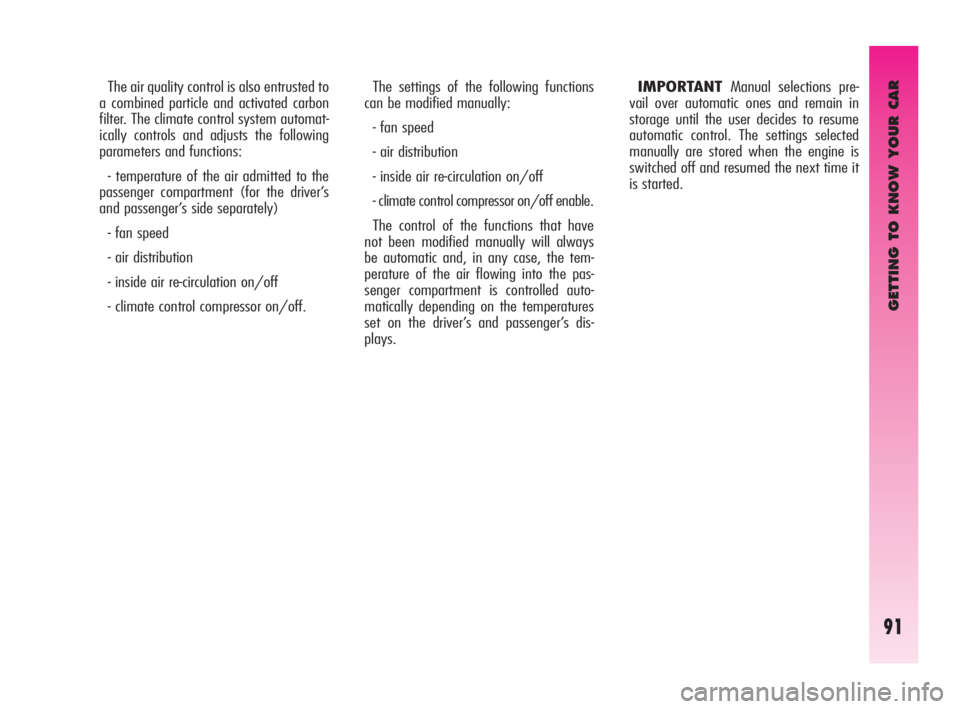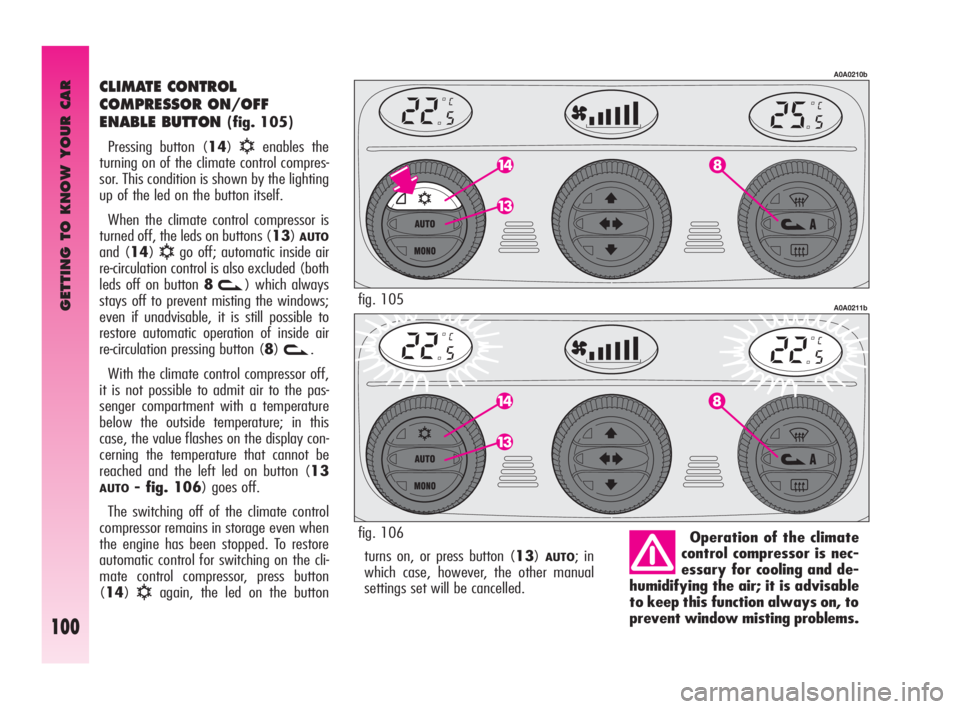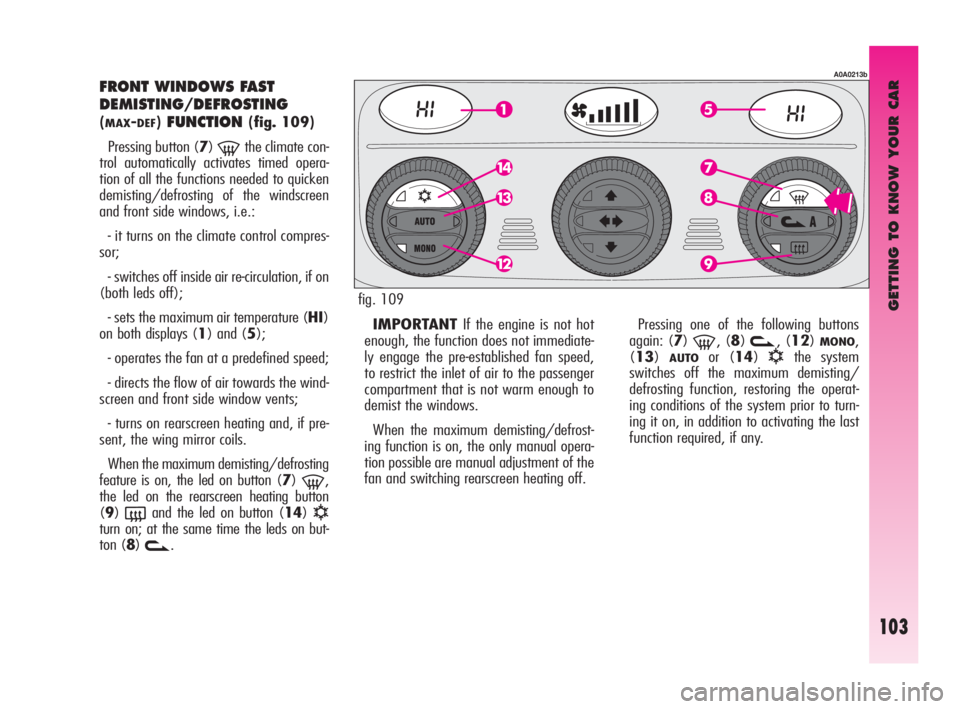engine Alfa Romeo GT 2010 Owner handbook (in English)
[x] Cancel search | Manufacturer: ALFA ROMEO, Model Year: 2010, Model line: GT, Model: Alfa Romeo GT 2010Pages: 271, PDF Size: 5.34 MB
Page 93 of 271

GETTING TO KNOW YOUR CAR
91
The air quality control is also entrusted to
a combined particle and activated carbon
filter. The climate control system automat-
ically controls and adjusts the following
parameters and functions:
- temperature of the air admitted to the
passenger compartment (for the driver’s
and passenger’s side separately)
- fan speed
- air distribution
- inside air re-circulation on/off
- climate control compressor on/off. The settings of the following functions
can be modified manually:
- fan speed
- air distribution
- inside air re-circulation on/off
- climate control compressor on/off enable.
The control of the functions that have
not been modified manually will always
be automatic and, in any case, the tem-
perature of the air flowing into the pas-
senger compartment is controlled auto-
matically depending on the temperatures
set on the driver’s and passenger’s dis-
plays.IMPORTANTManual selections pre-
vail over automatic ones and remain in
storage until the user decides to resume
automatic control. The settings selected
manually are stored when the engine is
switched off and resumed the next time it
is started.
Page 97 of 271

GETTING TO KNOW YOUR CAR
95
HI function
(highest heating power - fig. 99)
This is turned on setting on the display a
temperature above 32.5°C, and can be
activated independently from the driver’s
or passenger’s side or both; this setting
brings the system to the “monozone”
mode and is shown on both displays.
This function can be engaged when
requiring to heat the passenger compart-
ment as quickly as possible, exploiting the
maximum potential of the system.
This function uses the maximum temper-
ature of the coolant fluid, while air distrib-
ution and fan speed are controlled accord-
ing to the system settings.
This function is unadvisable with
the engine cold to prevent admit-
ting air that is not warm enough
to the passenger compartment.
All manual settings are possible with this
function on.
To switch the system off, simply turn the
ring of knob (2) or (6) of the tempera-
ture set to a value below 32.5°C; the
opposite display will show 32.5°C.
A0A0218b
fig. 99
Pressing key (13)
AUTOthe display will
show a temperature of 32.5°C and returns
to an operating condition with automatic
temperature adjustment.
Page 102 of 271

GETTING TO KNOW YOUR CAR
100
turns on, or press button (13)AUTO; in
which case, however, the other manual
settings set will be cancelled.
CLIMATE CONTROL
COMPRESSOR ON/OFF
ENABLE BUTTON
(fig. 105)
Pressing button (14)
√enables the
turning on of the climate control compres-
sor. This condition is shown by the lighting
up of the led on the button itself.
When the climate control compressor is
turned off, the leds on buttons (13)
AUTO
and (14)√go off; automatic inside air
re-circulation control is also excluded (both
leds off on button 8
v) which always
stays off to prevent misting the windows;
even if unadvisable, it is still possible to
restore automatic operation of inside air
re-circulation pressing button (8)
v.
With the climate control compressor off,
it is not possible to admit air to the pas-
senger compartment with a temperature
below the outside temperature; in this
case, the value flashes on the display con-
cerning the temperature that cannot be
reached and the left led on button (13
AUTO- fig. 106) goes off.
The switching off of the climate control
compressor remains in storage even when
the engine has been stopped. To restore
automatic control for switching on the cli-
mate control compressor, press button
(14)
√again, the led on the buttonOperation of the climate
control compressor is nec-
essary for cooling and de-
humidifying the air; it is advisable
to keep this function always on, to
prevent window misting problems.
A0A0210b
A0A0211bfig. 105
fig. 106
Page 105 of 271

GETTING TO KNOW YOUR CAR
103
FRONT WINDOWS FAST
DEMISTING/DEFROSTING
(MAX-DEF)FUNCTION(fig. 109)
Pressing button (7)
-the climate con-
trol automatically activates timed opera-
tion of all the functions needed to quicken
demisting/defrosting of the windscreen
and front side windows, i.e.:
- it turns on the climate control compres-
sor;
- switches off inside air re-circulation, if on
(both leds off);
- sets the maximum air temperature (HI)
on both displays (1) and (5);
- operates the fan at a predefined speed;
- directs the flow of air towards the wind-
screen and front side window vents;
- turns on rearscreen heating and, if pre-
sent, the wing mirror coils.
When the maximum demisting/defrosting
feature is on, the led on button (7)
-,
the led on the rearscreen heating button
(9)
(and the led on button (14)√turn on; at the same time the leds on but-
ton (8)
v.IMPORTANTIf the engine is not hot
enough, the function does not immediate-
ly engage the pre-established fan speed,
to restrict the inlet of air to the passenger
compartment that is not warm enough to
demist the windows.
When the maximum demisting/defrost-
ing function is on, the only manual opera-
tion possible are manual adjustment of the
fan and switching rearscreen heating off. Pressing one of the following buttons
again: (7)
-, (8)v, (12)MONO,
(13)
AUTOor (14)√the system
switches off the maximum demisting/
defrosting function, restoring the operat-
ing conditions of the system prior to turn-
ing it on, in addition to activating the last
function required, if any.
A0A0213b
fig. 109
Page 106 of 271

GETTING TO KNOW YOUR CAR
104
WING MIRROR AND
REARSCREEN
DEFROSTING/DEMISTING
BUTTON
(fig. 110)
Pressing button (9)
(turns on
demisting/defrosting of the rearscreen
and, if present, the wing mirror coils.
The turning on of this function is shown
by the turning on of the led on the button.
This function is timed and switches off
automatically after 20 minutes, or press-
ing the button again; the function is also
switched off when the engine is stopped
and will not be switched on again the next
time the engine is started.
IMPORTANTThe system automatical-
ly turns on rearscreen heating if the tem-
perature is below 3°C.
IMPORTANTDo not apply stickers on
the inside of the rearscreen over the heat-
ing filaments to avoid damage that might
cause it to stop working properly.
POLLEN FILTER
Have the conditions of the filter checked
by Alfa Romeo Authorised Services at least
once a year, preferably at the onset of
summer.
If the car is used mainly in dusty or pol-
luted areas it should be checked and, if
necessary, replaced at shorter intervals.
A0A0214b
The filter has the specific capability of fil-
tering external air, thus admitting to the
passenger compartment purified air, free
from particles such as dust, pollen, etc.
In addition to the above mentioned func-
tions, is also reduces the concentration of
pollutants.
The filtering action takes place under all
air inlet conditions and it is clearly most
effective with the windows shut.If the filter is not replaced
the efficiency of the cli-
mate control system may
be seriously compromised up to
blocking the air flow at the outlets
and vents.
fig. 110
Page 108 of 271

GETTING TO KNOW YOUR CAR
106
CONTROLS
TAILGATE OPENING (fig. 112)
Electric tailgate release is only allowed with
the ignition key in the ignition switch at
MARcar stationary, at STOPorPARK
for 3 minutes without opening/closing a
door. To release the tailgate, press button
(A) on the central console panel.
HAZARD WARNING LIGHTS
(fig. 112)
They are switched on by pressing button
(C), on the central console panel, regard-
less of the position of the ignition key.
When the hazard lights are switched on,
the switch itself begins to flash together with
the direction indicators and warning lights
on the instrument panel. This function is
switched off by pressing the button again. Use of the hazard lights is
ruled by the Highway Code
of the country in which the
car is used. Observe regulations.
FOG LIGHTS (fig. 112)
These are turned on pressing button (B),
on the centre console panel, when the out-
er lights are already on, at the same time
the led on the button itself turns on.
Press button (B) again to switch off.
IMPORTANTThe front foglights should
be used in compliance with the local traffic
laws.
fig. 112
A0A0091b
REAR FOG GUARDS (fig. 112)
These are turned on, with the dipped beam
headlights or fog lights on, pressing button
(D) on the centre console panel, at the
same time the warning light on the button
itself turns on.
Turning the ignition key to STOPthe fog
guards are automatically turned off and they
do not come on the next time the engine
is started unless button (D) is pressed. To
turn them off press button (D).
IMPORTANTAlways use the rear fog
guards in compliance with local regulations.
Page 111 of 271

GETTING TO KNOW YOUR CAR
109
To release the hand brake:
– slightly lift the lever (A) and press the
release button (B);
– keeping the button pressed lower the
lever, the warning light
xon the instru-
ment cluster will go out.
To prevent the car from moving acciden-
tally, keep the brake pedal pressed when
engaging the hand brake.
IMPORTANTThe hand brake lever (A)
is fitted with a safety device which prevents
the brake from being released when, with
the lever pulled, button (B) is pressed.
Therefore, to release the brake, in addition
to pressing button (B), it is also necessary
to pull lever (A) further upwards to release
the safety device, then lower the lever com-
pletely.
IMPORTANTOn certain versions a
buzzer sounds to alert the driver if the car
is moved with the hand brake engaged.
GEARSHIFT LEVER (fig. 116)
The position of the single gears is shown
by the pictogram on the gearshift lever knob.
When shifting gear, always fully depress
the clutch pedal. Before engaging reverse
gear (R) wait for the car to be stationary.
Certain versions are equipped with 6-speed
gearbox. For the versions with 6 gears, to
engage reverse (R) lift (with the fingers
of the same hand holding the lever) the ring
(A-fig. 116) positioned under the lever.
After engaging the reverse, release the ring.
To change from reverse to another gear, it
is not necessary to lift the ring on the lever.
IMPORTANTReverse gear may only be
engaged with the car completely at a stand-
still. With the engine running, before en-
gaging reverse gear it is necessary to wait
for at least 3 seconds with the clutch pedal
fully depressed to prevent clashing and the
possibility of damaging the gears. To change gear smoothly,
the clutch pedal must be
fully depressed. Therefore,
there should be no obstacles on the
floor under the pedal unit: make
sure that any mats are well laid and
do not interfere with the pedals.
fig. 116
A0A0684b
Page 113 of 271

GETTING TO KNOW YOUR CAR
111
SYSTEM ACTIVATION
IMPORTANTOpening the driver’s door,
the Selespeed starts the hydraulic part of
the system to prepare it for the engine to be
started.
Turning the ignition key to MAR, all the
segments of the display (fig. 119), the
gearbox warning light (fig. 120) and the
wordCITYturn on. After about one second,
the display indicates the gear engaged (N,
1,2,3,4,5,R).
IMPORTANTIf after 10 seconds the dis-
play segment do not display the gear en-
gaged or the warning light stays on, turn the
ignition key to STOPand wait for the dis-
play to go off, then repeat the system acti-
vation procedure. If the fault persists, con-
tact Alfa Romeo Authorized Services. With gearshift to CITYgears can be shift-
ed manually using both the gearshift lever
or the steering wheel controls. Gearshift
stays in CITY.
The gear selected (fig. 119) is always
displayed regardless of the mode being se-
lected selected .
N= neutral;
1= first gear;
2= second gear;
3= third gear;
4= fourth gear;
5= fifth gear;
R= reverse. InCITYorSPORT, the selected mode is
also displayed.
IMPORTANT SPORTmode can only
be activated after deactivating the CITY
mode.
A warning light, a message (fig. 120)
and a buzzer draw the attention of the dri-
ver in the event of a fault at Selespeed trans-
mission.
The Selespeed considerably simplifies use
of the car, reducing the fatigue of city dri-
ving or when frequent gearshifting is re-
quired, at the same time offering brilliant
performance.
fig. 120
A0A9081g
Page 114 of 271

GETTING TO KNOW YOUR CAR
112
If the car is on the move, the request is
not accepted; wait for the car to stop and
then request reverse gear engagement
again.
IMPORTANTOnce a gear has been
changed it is necessary to immediately re-
lease the gearshift control lever after mak-
ing the request. A manoeuvre prolonged
(over 10 seconds) makes the system au-
tomatically switch to CITYmode; every-
thing stops releasing the gearshift lever.
IMPORTANTIf wanting to leave the car
parked on a sloping road with a gear en-
gaged to keep it braked, it is necessary to
check that the display shows the new gear
engaged and then wait for 1 to 2 seconds
before releasing the brake pedal to allow
complete clutch engagement.
fig. 123
A0A0700b
OPERATION WITH ENGINE OFF
IMPORTANTBefore using the gearshift
control lever, always check the gear en-
gaged on the display (N,1,2,3,4,5,
R).
With the engine off and the car station-
ary it is possible to engage all the gears.
With the car stationary and with the brake
pedal pressed, requests to shift gears are
both accepted through the control lever on
the central console or through the steering
wheel levers.
To request gearshifting, in addition to keep-
ing the brake pedal pressed:
– to shift upwards (+) (fig. 121) push
the lever “forwards” (if the car is in first gear
it shifts to second, if in second it shifts to
third and so on up to fifth). If the system
is in neutral (N) or reverse (R) moving thelever forwards causes the engagement of
first gear (1).
– to shift downwards (–) (fig. 121)
push the lever backwards (if the car is in
fifth gear it shifts to fourth, if in fourth it
shifts to third and so on down to first gear).
To allow setting the transmission to neu-
tral (N), starting from the condition with
the car stationary and brake pedal pressed,
move the gearshift lever to the right (fig.
122).
From any gear (N,1,2,3,4,5) and
with the car practically at a standstill, it is
possible to request engagement of reverse
gear, pushing the lever to the right and then
backwards (fig. 123).
fig. 121
A0A0698b
fig. 122
A0A0699b
Page 115 of 271

GETTING TO KNOW YOUR CAR
113
Never remove the ignition
key when the car is mov-
ing. In addition to the fact
that the Selespeed system would
not work properly up to stopping
the car, the steering wheel would
lock automatically the first time it
is turned.
STARTING THE ENGINE
The engine can be started with the gear
engaged or in neutral (N), provided that the
brake pedal is pressed down.
IMPORTANTKeep the pedal fully de-
pressed during starting. Since the brake ped-
al becomes hard if it is pressed repeatedly
with the engine off, in this situation it is nec-
essary to increase the pressure on the ped-
al itself to start the engine.
After starting, the gearbox sets to neutral
automatically, the display shows the letter
(N) and the system selects the operating
mode memorised before switching off.
If the engine fails to start
with the gear engaged, the
driver is alerted of the po-
tentially dangerous situation due
to the fact that the gearbox has
automatically set to neutral by the
buzzer and the display.
SWITCHING OFF THE ENGINE
AND SYSTEM DEACTIVATION
Turning the ignition key to STOPthe en-
gine switches off: the gear selected before
turning the engine off remains engaged.
If the engine stops with the gearbox in
neutral (N), the buzzer and the blinking
of (N) draw the attention of the driver so
that the car can be put in safety conditions
engaging the first gear (1) or reverse (R).
In this case, it is necessary to turn the igni-
tion key to MARand with the brake ped-
al pressed, engage first gear (1) or reverse
(R).
NEVER leave the car with
the gears in neutral (N).
It is absolutely necessary
to turn off the engine con-
sequently deactivating the
Selespeed system keeping the brake
pedal pressed: release the pedal
ONLY when the display goes off.